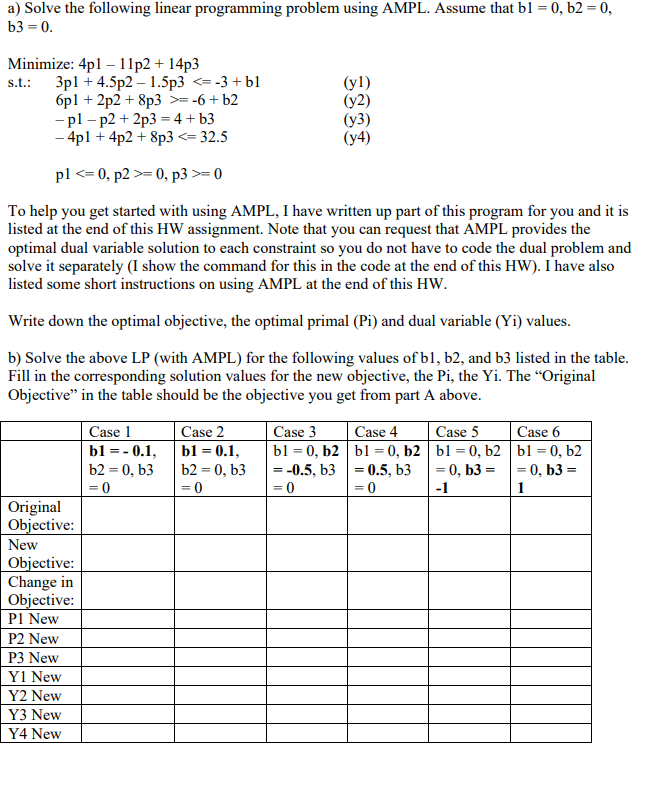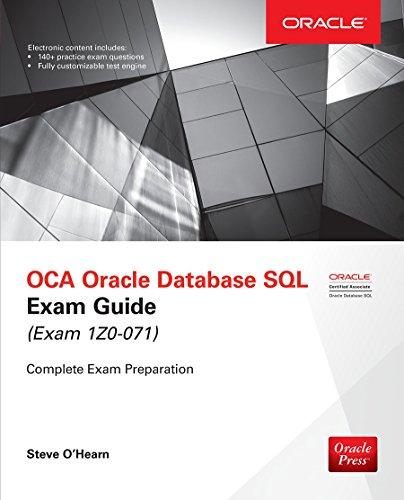

a) Solve the following linear programming problem using AMPL. Assume that bl = 0, b2 = 0, b3 = 0. Minimize: 4p1 - 11p2 + 14p3 s.t.: 3pl +4.5p2 - 1.5p3 = -6 + b2 -pl - p2 + 2p3 = 4+b3 - 4p1 + 4p2 + 8p3 = 0,p3 >=0 To help you get started with using AMPL, I have written up part of this program for you and it is listed at the end of this HW assignment. Note that you can request that AMPL provides the optimal dual variable solution to each constraint so you do not have to code the dual problem and solve it separately (I show the command for this in the code at the end of this HW). I have also listed some short instructions on using AMPL at the end of this HW. Write down the optimal objective, the optimal primal (Pi) and dual variable (Yi) values. b) Solve the above LP (with AMPL) for the following values of b1,b2, and b3 listed in the table. Fill in the corresponding solution values for the new objective, the Pi, the Yi. The Original Objective in the table should be the objective you get from part A above. Case 2 b1 = 0.1, b2 = 0, b3 Case 3 Case 4 Case 5 Case 6 b1 = 0, b2b1 = 0, b2b1 = 0, b2b1 = 0, b2 = -0.5, b3 -0.5, b3 = 0, b3 = = 0, b3 = = 0 = 0 -1 1 Case 1 b1 = -0.1, b2 = 0, b3 = 0 Original Objective: New Objective: Change in Objective: P1 New P2 New P3 New Y1 New Y2 New Y3 New Y4 New c) For each case listed above, explain if the change to the LP expanded the feasible set of solutions (relaxation - created a superset of solutions), tightened the feasible set of solutions (restricted - created a subset of solutions), state that neither occurred (it created a different feasible set of solutions that is not a subset or a superset of the original feasible set of solutions), or state that it is not possible to know how it changed the feasible set of solutions. d) For cases 1 and 2, only bl is changed. Is the change in the objective equal to bl*yl (yl's answer from part A)? Explain for both case 1 and case 2. If it is not equal to bl*yl, then explain why. e) For cases 3 and 4, only b2 is changed. Is the change in the objective equal to b2*y2 (y2's answer from part A)? Explain for both case 3 and case 4. If it is not equal to b2*y2, then explain why. f) For cases 5 and 6, only b3 is changed. Is the change in the objective equal to b3*y3 (y3s answer from part A)? Explain for both case 5 and case 6. If it is not equal to b3*y3, then explain why. You are required to turn in any AMPL code that you used with this problem. a) Solve the following linear programming problem using AMPL. Assume that bl = 0, b2 = 0, b3 = 0. Minimize: 4p1 - 11p2 + 14p3 s.t.: 3pl +4.5p2 - 1.5p3 = -6 + b2 -pl - p2 + 2p3 = 4+b3 - 4p1 + 4p2 + 8p3 = 0,p3 >=0 To help you get started with using AMPL, I have written up part of this program for you and it is listed at the end of this HW assignment. Note that you can request that AMPL provides the optimal dual variable solution to each constraint so you do not have to code the dual problem and solve it separately (I show the command for this in the code at the end of this HW). I have also listed some short instructions on using AMPL at the end of this HW. Write down the optimal objective, the optimal primal (Pi) and dual variable (Yi) values. b) Solve the above LP (with AMPL) for the following values of b1,b2, and b3 listed in the table. Fill in the corresponding solution values for the new objective, the Pi, the Yi. The Original Objective in the table should be the objective you get from part A above. Case 2 b1 = 0.1, b2 = 0, b3 Case 3 Case 4 Case 5 Case 6 b1 = 0, b2b1 = 0, b2b1 = 0, b2b1 = 0, b2 = -0.5, b3 -0.5, b3 = 0, b3 = = 0, b3 = = 0 = 0 -1 1 Case 1 b1 = -0.1, b2 = 0, b3 = 0 Original Objective: New Objective: Change in Objective: P1 New P2 New P3 New Y1 New Y2 New Y3 New Y4 New c) For each case listed above, explain if the change to the LP expanded the feasible set of solutions (relaxation - created a superset of solutions), tightened the feasible set of solutions (restricted - created a subset of solutions), state that neither occurred (it created a different feasible set of solutions that is not a subset or a superset of the original feasible set of solutions), or state that it is not possible to know how it changed the feasible set of solutions. d) For cases 1 and 2, only bl is changed. Is the change in the objective equal to bl*yl (yl's answer from part A)? Explain for both case 1 and case 2. If it is not equal to bl*yl, then explain why. e) For cases 3 and 4, only b2 is changed. Is the change in the objective equal to b2*y2 (y2's answer from part A)? Explain for both case 3 and case 4. If it is not equal to b2*y2, then explain why. f) For cases 5 and 6, only b3 is changed. Is the change in the objective equal to b3*y3 (y3s answer from part A)? Explain for both case 5 and case 6. If it is not equal to b3*y3, then explain why. You are required to turn in any AMPL code that you used with this








